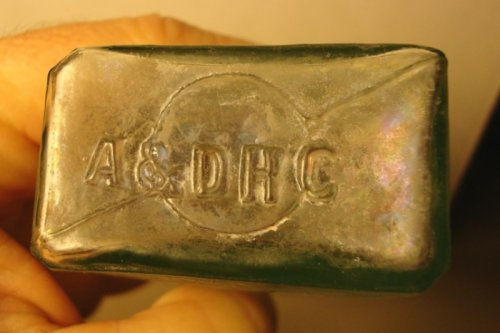You are using an out of date browser. It may not display this or other websites correctly.
You should upgrade or use an alternative browser.
You should upgrade or use an alternative browser.
Odd medicine base
- Thread starter GuntherHess
- Start date
cyberdigger
Well-Known Member
..from "quick-draw cyber" :
[font="sans-serif, arial, helvetica, geneva"]A. & D. H. C. .........Alexander & David H. Chambers, Pittsburgh, PA (1843-c.1889). This was one of the most prolific glass companies in Pittsburgh during the mid-to-late 1800s. Huge quantities of bottles, flasks, and fruit jars were made, as well as window glass. Many local, regional, and nationally distributed sodas, mineral waters, beers, bitters, tonics, and other types of products were packaged in bottles made by A&DHC. Most commonly, bottles with this mark usually seem to date from the 1870s and 1880s, but the mark was probably in use at least from around the start of the Civil War, perhaps a bit earlier.
..how it was made definitely eludes me!!
[/font]
[font="sans-serif, arial, helvetica, geneva"]A. & D. H. C. .........Alexander & David H. Chambers, Pittsburgh, PA (1843-c.1889). This was one of the most prolific glass companies in Pittsburgh during the mid-to-late 1800s. Huge quantities of bottles, flasks, and fruit jars were made, as well as window glass. Many local, regional, and nationally distributed sodas, mineral waters, beers, bitters, tonics, and other types of products were packaged in bottles made by A&DHC. Most commonly, bottles with this mark usually seem to date from the 1870s and 1880s, but the mark was probably in use at least from around the start of the Civil War, perhaps a bit earlier.
..how it was made definitely eludes me!!
[/font]
GuntherHess
Well-Known Member
I guess its a bottle mystery for Red.
RED Matthews
Well-Known Member
Hi Matt and Cyberdigger.
I guess its a bottle mystery for Red.
Well I wrote a reply and got timed out or something.
Now I have to write it again. Well the first point was: The bottle had to be made in a two - part bottom hinged mold. This was not uncommon in the period of time when one half of the mold was attached to a working steel post and a mold boy opened the mold from a position in front of and below where the bottle blower stood to work.
The two halves of the mold closed around a round post and the embossing was cut in to match up when together in the final blow moment. It is obvious that the “/ & †sign was botched up a little on the match of the two metal parts. It also looks like there was a mark produced over the lower part of the “/ C †by the cutting or mold detail life. It is also noticeable that the side corner edges not on the parting seams were beveled, while the ones on the parting corner did not shoe the same beveled edge.
Thanks for thinking of my evaluation. RED Matthews
I guess its a bottle mystery for Red.
Well I wrote a reply and got timed out or something.
Now I have to write it again. Well the first point was: The bottle had to be made in a two - part bottom hinged mold. This was not uncommon in the period of time when one half of the mold was attached to a working steel post and a mold boy opened the mold from a position in front of and below where the bottle blower stood to work.
The two halves of the mold closed around a round post and the embossing was cut in to match up when together in the final blow moment. It is obvious that the “/ & †sign was botched up a little on the match of the two metal parts. It also looks like there was a mark produced over the lower part of the “/ C †by the cutting or mold detail life. It is also noticeable that the side corner edges not on the parting seams were beveled, while the ones on the parting corner did not shoe the same beveled edge.
Thanks for thinking of my evaluation. RED Matthews
GuntherHess
Well-Known Member
So you are saying they cut the embossing while the mold halves were separated (they had to right?) If so its amazing they were able to make it line up so well.
Red, it is quite a pain when you get timed out typing.
I would recommend typing any lengthy replies in a text editor like Notepad or Wordpad.
They you can just cut and paste into the forum message window.
Thanks for replying.
-Matt
Red, it is quite a pain when you get timed out typing.
I would recommend typing any lengthy replies in a text editor like Notepad or Wordpad.
They you can just cut and paste into the forum message window.
Thanks for replying.
-Matt
GuntherHess
Well-Known Member
Here is another odd medicine base...
http://www.antiquemedicines.com/MattsMedicines/1292/Sweet3.JPG
This base has a backwards '4' some semicircular designs and partial lettering.
I am thinking that these markings where not actually on the mold but were on the work surface or annealing rack (explaining why the 4 is mirrored) . I have heard of some other bottles having similar marks.
http://www.antiquemedicines.com/MattsMedicines/1292/Sweet3.JPG
This base has a backwards '4' some semicircular designs and partial lettering.
I am thinking that these markings where not actually on the mold but were on the work surface or annealing rack (explaining why the 4 is mirrored) . I have heard of some other bottles having similar marks.
Similar threads
- Replies
- 12
- Views
- 1K
- Replies
- 5
- Views
- 1K
Latest threads
-
Who made this case gin?
- Started by Boundary Country
- Replies: 2
-
-
Killer Dig with Pot Lids and lot of other stoneware!
- Started by RIBottleguy
- Replies: 0
-
-
-


